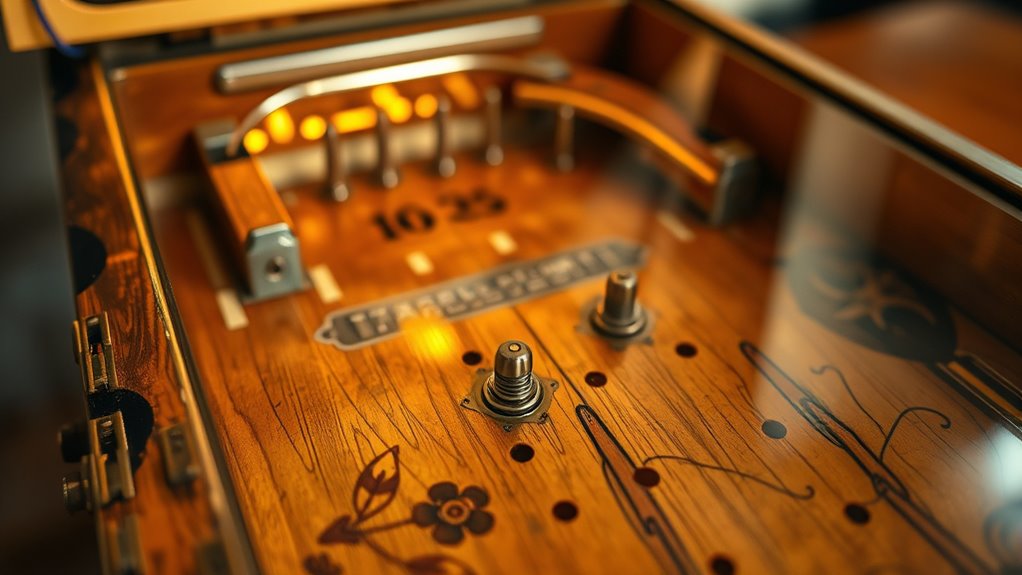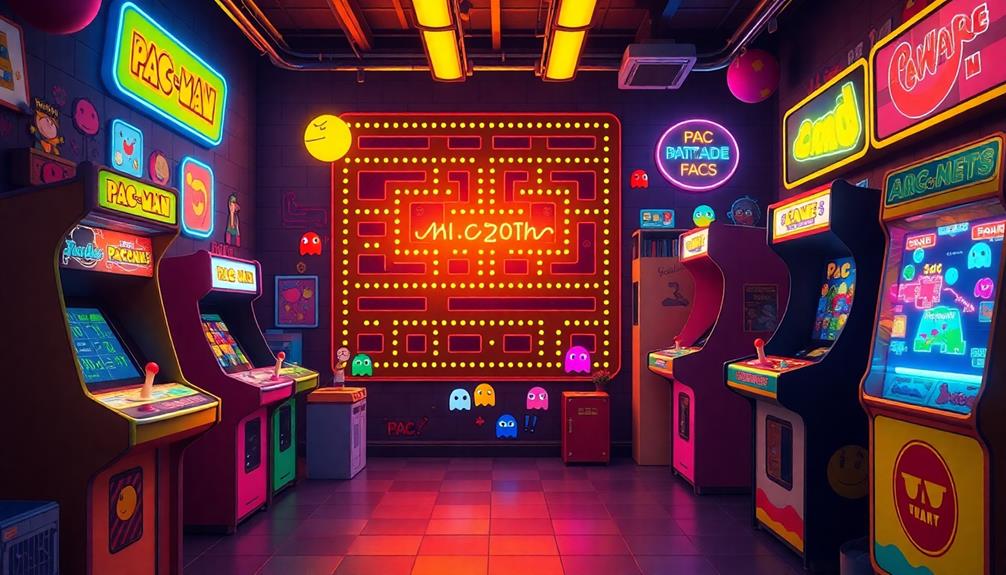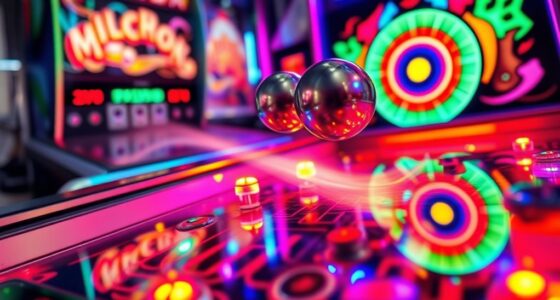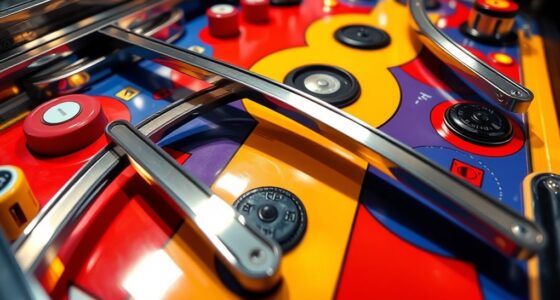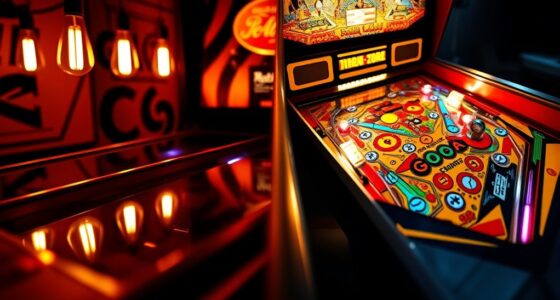Pinball began in the 18th century with the game of bagatelle, which involved shooting balls onto a sloped table to score points. Originally a gambling game, players sought to make it more skill-based by adding bumpers, flippers, and scoring features. Over time, the game evolved from chance to a competitive pursuit. If you keep exploring, you’ll discover how technological advances and cultural changes shaped the modern pinball experience we enjoy today.
Key Takeaways
- Pinball originated from the 18th-century game bagatelle, initially involving chance and gambling elements.
- Modifications shifted the focus from gambling to skill, transforming bagatelle into a recreational game.
- 20th-century innovations added mechanical and electrical features like bumpers and flippers, increasing interactivity.
- The introduction of flippers in the late 1940s revolutionized gameplay, making it more skill-based and sparking legal challenges.
- Modern pinball evolved with electronic features, themed tables, and digital technology, blending tradition with contemporary entertainment.
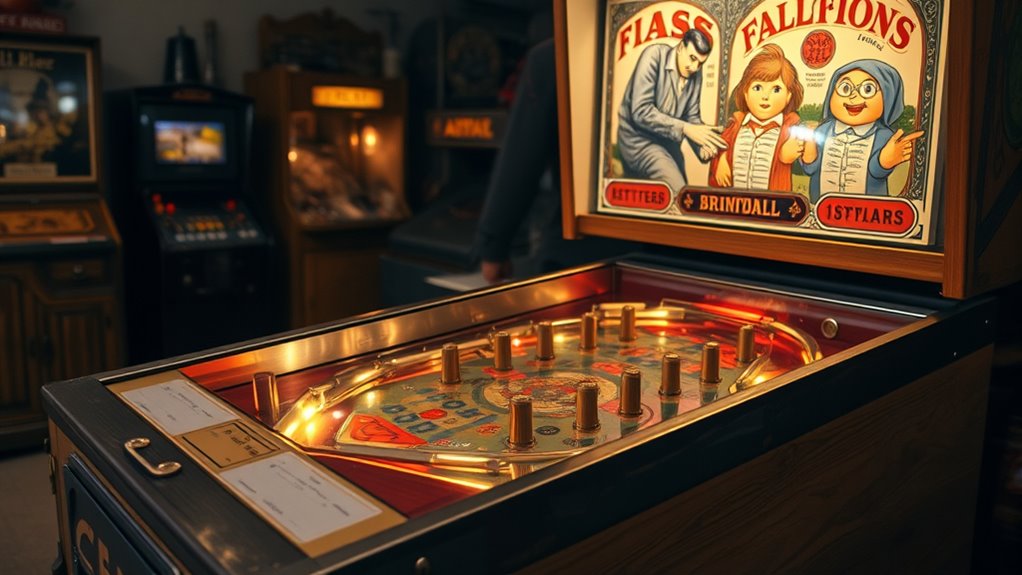
Have you ever wondered where pinball games originated? The story begins long before modern arcades, rooted in a fascinating blend of the history of gambling and the evolution of arcade games. In the 18th and 19th centuries, people played a game called bagatelle, a precursor to pinball. It involved using cues to shoot balls onto a sloped table, aiming to land in scoring holes. Originally, bagatelle was a gambling game, and its popularity grew as people enjoyed the thrill of chance combined with skill. Over time, players sought ways to make the game less about betting and more about skillful play, leading to modifications that transformed it into a purely entertainment-focused game. These changes laid the groundwork for what we now recognize as pinball.
As the 20th century approached, the evolution of arcade games gained momentum. Manufacturers began experimenting with mechanical devices and electrical components, adding bumpers, flippers, and scoring mechanisms to the game. These innovations made the game more interactive and engaging, shifting its focus from gambling to skill and entertainment. During the 1930s and 1940s, pinball machines became widely popular, especially in arcades, bars, and amusement parks. The addition of flippers in the late 1940s was a game-changer, allowing players to control the ball and aim for high scores, elevating pinball into a skill-based game rather than just luck. This shift also prompted legal battles, as some regions considered pinball a form of gambling, leading to bans that lasted for decades.
Despite these challenges, pinball’s popularity persisted and grew, thanks to innovative designs and the emergence of themed tables based on movies, comics, and pop culture. The shift from mechanical to electronic pinball machines in the 1970s marked another milestone, bringing digital scoring, sound effects, and animated features. These advancements made the game even more immersive, appealing to a broader audience. Today, modern pinball tables combine digital technology with traditional gameplay, reflecting centuries of evolution from simple gambling devices to complex, skill-based entertainment. This evolution is also influenced by artistic designs and thematic creativity, which continue to enhance player engagement. So, when you play a game of pinball, you’re experiencing a tradition that has traveled through centuries—one shaped by the history of gambling, the evolution of arcade games, and a relentless drive to innovate and entertain.
Frequently Asked Questions
How Did Pinball Evolve From Mechanical to Electronic Gameplay?
You saw pinball evolve from mechanical to electronic gameplay as technology advanced, replacing bumpers and levers with electronic sensors and displays. Today, you can even experience virtual reality pinball, making gameplay more immersive. Multiplayer options let you challenge friends online, adding social excitement. This shift means you enjoy more dynamic, customizable, and interactive pinball experiences, blending traditional fun with cutting-edge innovations that keep the game fresh and engaging for players like you.
What Were the Key Technological Innovations in Pinball History?
You see, key technological innovations in pinball history include the introduction of flipper mechanics in the 1940s, which revolutionized gameplay by allowing players to control the ball better. Additionally, score enhancement features like electronic displays and bumpers added excitement and complexity. These advancements transformed pinball from simple mechanical devices into dynamic, interactive games, engaging players with precise control and real-time scoring updates.
How Did Pinball’s Legal Status Change Over the Years?
You’ll find that pinball’s legal status shifted from being considered gambling to a game of skill. Initially, casinos and regulators saw it as illegal gambling, leading to bans. Over time, players and manufacturers argued it was purely skill-based, prompting regulatory changes. These legal battles helped lift bans, allowing pinball to flourish as a popular pastime. Today, most regions recognize it as entertainment, not casino gambling, and regulate it accordingly.
Who Were the Pioneering Designers of Early Pinball Machines?
You should know that designer pioneers like Raymond Maloney and David Gottlieb led the way in early pinball machine design. These early inventors experimented with mechanics and gameplay, transforming bagatelle into a competitive, commercial game. Their innovations laid the foundation for the modern pinball industry, inspiring future designers. By creating engaging, innovative machines, these pioneers shaped the evolution of pinball from simple amusement devices to complex, enthralling tables.
What Cultural Influences Shaped the Development of Pinball?
They say “art imitates life,” and you’ll see how cultural symbolism and artistic movements shaped pinball’s development. You notice how Art Deco’s sleek designs and the rise of mass entertainment influenced game aesthetics. Societal values, like luck and skill, reflected broader cultural themes. These influences made pinball a mirror of its time, blending art and entertainment, showing that what’s popular often reflects deeper cultural currents.
Conclusion
Now that you know how pinball evolved from simple bagatelle games to today’s high-tech tables, remember: history often repeats itself. By understanding its roots, you gain a greater appreciation for the game’s innovation and charm. So, next time you step up to a pinball machine, play with the knowledge that you’re part of a long, fascinating tradition. As they say, “A little history goes a long way,” and it truly does in pinball’s story.
